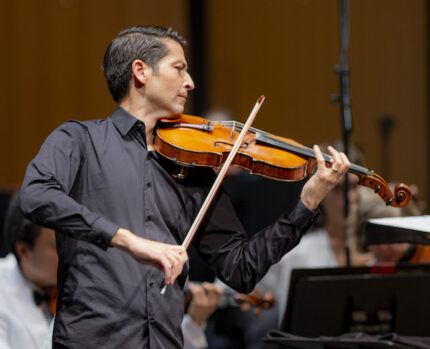Montgomery premiere upstages the showpieces at Harris Theater

Thanks, Lollapalooza.
Every summer when Chicago’s pop music extravaganza moves into the south end of Grant Park, the eponymous music festival moves out of the Pritzker Pavilion, its open-air home at the park’s north end. “Sound bleed” does not begin to describe the sternum-rattling thumps Lollapalooza musicians send into the air during the weekend-long megafest.
This weekend in the Harris Theater, however, the Grant Park Orchestra is treating Lollapalooza as a plus rather than a minus. Under guest conductor Eric Jacobsen, it’s channeling the energy and high spirits filling the Loop as thousands of young concertgoers head toward Lollapalooza stages—into a lively program featuring music about cities and festivals. Friday night’s concert mixed familiar pieces by Dvorak, Copland and Respighi with an exuberant Grant Park co-commission, Jessie Montgomery’s L.E.S. Characters.
Written in 2021 for viola and orchestra and featuring violist Masumi Per Rostad, Montgomery’s piece was the concert’s highlight, heard in its local premiere. She is the Chicago Symphony Orchestra’s composer in residence, and her widely performed music is always full of color with tinges of jazz, blues, Latin American and other genres too numerous to name.
L.E.S. refers to New York City’s Lower East Side, the vibrant and diverse neighborhood where Montgomery grew up in the 1980s. Its five distinct sections with titles like “The Can Man,” “Mosaic Man” and “The Poet” vividly portray characters that obviously dazzled Montgomery as she roamed the neighborhood as a child.
Sporting a body suit made of aluminum cans, The Can Man traveled the streets atop a unicycle. Rostad’s energetic viola circled and swooped in short yet lyrical phrases above the amiably random clatter of metallic percussion. His solo lines evoked the mesmerizing sight of a unicyclist maintaining his balance while furiously pedaling in ever-tightening circles.
The Mosaic Man was an artist who covered the physical wounds of the neighborhood’s streetscape—a rusted out light pole, a hole in a fence—with bits and pieces of ceramics. Under Jacobsen’s attentive direction, the Grant Park strings were lustrous and full-bodied, its brass warmly burnished. Rostad’s sharply etched viola lines cut into the orchestra’s sound, overlaying their rich undercurrent with glittering, jagged edges.
Montgomery and Rostad grew up together, and she wrote L.E.S. Characters with him in mind. (Local audiences know him as a former long-time member of the Pacifica Quartet.) Portraying Montgomery’s carefully sketched characters, we felt Rostad’s own lived experience of noisy, crowded city streets.
In the final movement, “The Can Man (Reprise),” the formerly carefree mood became more tense, the viola’s flights and swirls more unstable. Thudding drum beats, first heard in the “Garbage Art” movement, intruded on the Can Man’s song. In “Garbage Art” they were the reassuring sound of a city going about its everyday, often unglamorous, life. In “The Can Man (Reprise),” their outbursts were more menacing.

The concert got off to an explosively cheerful start with Dvořák’s kaleidoscopic Carnival Overture. The Harris Theater acoustic is crystal clear, and we heard every detail of Dvořák’s folk-flavored woodwind dances and bounding brass. But the music’s underlying flow, from the magical emergence of an undulating harp to the soothing arrival of more introspective melodies, was often lost.
The acoustic also did no favors to Copland’s evocative Quiet City (a slyly witty choice for one of downtown noisiest weekends.) Soloists David Gordon, Grant Park’s principal trumpet, and Anne Bach on English horn were richly eloquent as they floated Copland’s haunting melodies over the serenely murmuring orchestra. But the overall sound was too loud to fully capture the work’s mysterious shading.
In such a bright hall, quieter playing from orchestra and soloists might have helped.
On the other hand, the concert’s final work, Respighi’s roof-raising Pines of Rome, was a perfect choice for both the hall and the program’s celebrate-the-city theme. The orchestra’s rudely blatting horns and sing-song rhythms captured the happy chaos of children at play in “The Pines of the Villa Borghese” movement. In the final moments of “The Pines of the Appian Way,” the orchestra’s brasses and drums evoked the brute power of a victorious army swaggering its way home. With extra brass players in the balcony, Respighi’s music thundered through the hall, utterly engulfing the audience.
Lollapaloozans aren’t the only ones who like their sternums rattled.
The program will be repeated 7:30 p.m. Saturday in the Harris Theater, 205 E. Randolph. gpmf.org
Posted in Performances


